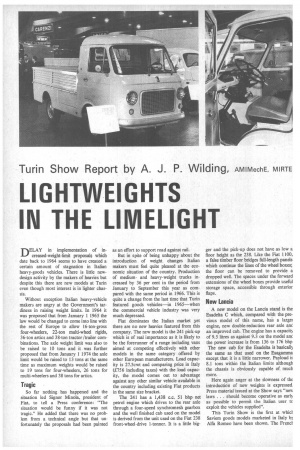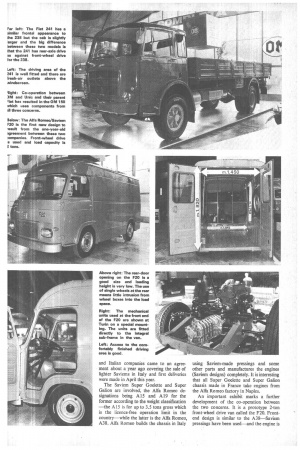LIGHTWEIGHTS IN THE LIMELIGHT
Page 112

Page 113

Page 114

If you've noticed an error in this article please click here to report it so we can fix it.
DELAY in implementation of increased-weight-limit proposals which date back to 1964 seems to have created a certain amount of stagnation in Italian heavy-goods vehicles. There is little newdesign activity by the makers of heavies but despite this there are new models at Turin even though most interest is in lighter chassis.
Without exception Italian heavy-vehicle makers are angry at the Government's tardiness in raising weight limits. In 1964 it was proposed that from January 1 1965 the law would be changed to come into line with the rest of Europe to allow 16-ton-gross four-wheelers, 22-ton multi-wheel rigids, 36-ton attics and 38-ton tractor/trailer combinations. The axle weight limit was also to be raised to 10 tons and it was further proposed that from January 1 1974 the axle limit would be raised to 13 tons at the same time as maximum weights would be raised to 19 tons for four-wheelers, 26 tons for multi-wheelers and 38 tons for artics.
Tragic
So far nothing has happened and the situation led Signor Minola, president of Fiat, to tell a Press conference: "The situation would be funny if it was not tragic." He added that there was no problem from a technical angle but that unfortunately the proposals had been painted as an effort to support road against rail.
But in spite of being unhappy about the introduction of weight changes Italian makers must feel quite pleased at the economic situation of the country. Production of mediumand heavy-weight trucks increased by 36 per cent in the period from January to September this year as compared with the same period in 1966. This is quite a change from the last time that Turin featured goods vehicles—in 1965—when the commercial vehicle industry was very much depressed.
Fiat dominates the Italian market yet there are no new heavies featured from this company. The new model is the 241 pick-up which is of real importance as it is likely to be the forerunner of a range including vans aimed at competing effectively with other models in the same category offered by other European manufacturers. Load capacity is 27.5cwt and comparing price in Italy (£756 including taxes) with the load capacity, the model comes out to advantage against any other similar vehicle available in the country including existing Fiat products in the same size bracket.
The 241 has a 1,438 c.c. 51 bhp net petrol engine which drives to the rear axle through a four-speed synchromesh gearbox and the well finished cab used on the model is derived from the unit used on the Fiat 238 front-wheel-drive 1-tonner. It is a little big ger and the pick-up does not have as low a floor height as the 238. Like the Fiat 1100, a false timber floor bridges full-length panels which continue the lines of the wheel boxes; the floor can be removed to provide a dropped well. The spaces under the forward extensions of the wheel boxes provide useful storage space, accessible through exterior flaps.
New Lancia
A new model on the Lancia stand is the Esadelta C which, compared with the previous model of this name, has a large' engine, new double-reduction rear axle an an improved cab. The engine has a capacity of 9.5 litres as against 9.3 on the model anc the power increase is from 136 to 176 bhp The new cab for the Esadelta is basicall3 the same as that used on the Esagamrna except that it is a little narrower. Payload is 8.1 tons within the Italian limits although the chassis is obviously capable of much more.
Here again anger at the slowness of the introduction of new weights is expressed. Press material issued at the Show says "new laws . . . should become operative as early as possible to permit the Italian user tc exploit the vehicles supplied".
This Turin Show is the first at whict Saviem goods models marketed in Italy 1)3 Alfa Romeo have been shown. The Frencl and Italian companies came to an agreement about a year ago covering the sale of lighter Saviems in Italy and first deliveries were made in April this year.
The Saviem Super Goelette and Super Galion are involved, the Alfa Romeo designations being A13 and A19 for the former according to the weight classification —the A15 is for up to 3.5 tons gross which is the licence-free operation limit in the country—while the latter is the Alfa Romeo, A38. Alfa Romeo builds the chassis in Italy using Saviem-made pressings and some other parts and manufactures the engines (Saviem designs) completely. It is interesting that all Super Goelette and Super Galion chassis made in France take engines from the Alfa Romeo factory in Naples.
An important exhibit marks a further development of the co-operation between the two concerns. It is a prototype 2-ton front-wheel drive van called the F20. Frontend design is similar to the A38—Saviem pressings have been used—and the engine is a Saviem-design four-cylinder three-litre petrol with an output of 72 bhp at 3,200 rpm. But as with the other Alfa Romeo/Savierr chassis the engine is built by the Italiar company.
The rest of the vehicle's mechanical unit; are wholly Alfa Romeo and the drive to the front wheels leaves the power unit an( transmission assembly between the engin( and the gearbox. Front suspension is in dependent through wishbones and torsior bars and because of the front wheel driv( the unladen floor height is only 17in. Nar row rear-wheel arches (single wheels an used here) do not protrude much inside dm
rear door width of 411 9in. and the rea opening measures 5ft 1 lin, in height. Interior
height •is 611 6in. and the sliding side door reveals an opening 511 8in. high by 3f 7in. wide. Even with a two-man passengei seat in the F20 van it is possible to get fron the driving area into the body.
International co-operation Among the heavier chassis at Turin then is another interesting example of co-opera lion between makers from different coun tries. But the link is Fiat whose units an used together with an engine from tit( Fiat-owned Unic of France in a new Olv model—now fully integrated with the Fia organisation. The model is the OM 151 which is designed for 15 tons gross althougl limited in Italy to 14 tons.
This four-wheeler has Fiat front and rea axles, gearbox, frame, other component such as fuel tank and air filter and drive and passenger seats, but the engine is a Unil 8.075 litre 176 bhp net six-cylinder diese The cab is the same as on the OM Titan( and the vehicle is built by OM.
Another innovation by OM at the Turi Show is the use of a higher-power supet charged engine in the heaviest goods mode made by the concern—the Titano. This is development of the previous big diesel mad by OM—under Saurer licence in respect c heads, pistons, induction system and supei charger. Bore has been increased from 12. to 130mm. and the maximum speed fror 2,000 rpm to 2,200 rpm which has resulte in an increase in output from 230 bhp net t 287 bhp net (305 bhp gross).
The supercharged version is an option; i




































































































































































































































































